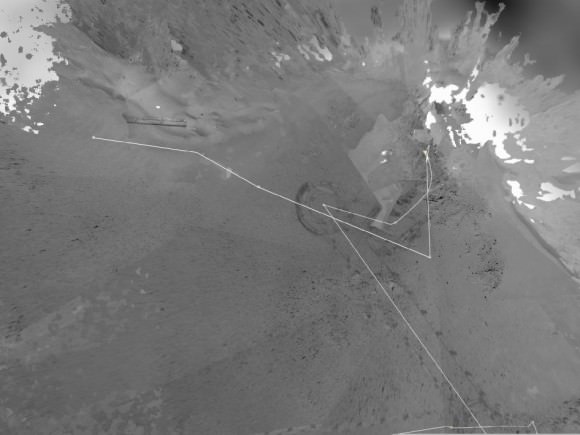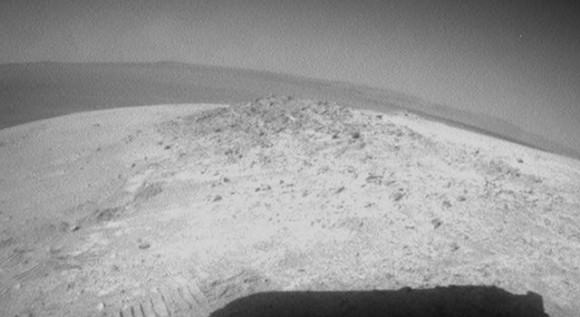
Opportunity's traverse map from Sol 2951 (May 13 on Earth) and shows the entirety of the rover's travels to that point. Image Credit: NASA/JPL/Cornell/University of Arizona
After spending 19 weeks working in one place during the Martian winter in Meridian Planum, the Opportunity Mars rover is now roving once again. During the winter, available solar power was too low for driving, but on May 8th (here on Earth), Opportunity took its first drive since Dec. 26, 2011. She drove about 3.67 meters (12 feet) northwest and downhill.
“We’re off the Greeley Haven outcrop onto the sand just below it,” said rover driver Ashley Stroupe of JPL. “It feels good to be on the move again.”
During the period while the rover was stationary, she wasn’t just sleeping. Engineers sent commands for Oppy to use the spectrometers and microscopic imager on its robotic arm to inspect more than a dozen targets within reach on the outcrop. Radio Doppler signals from the stationary rover during the winter months served an investigation of the interior of Mars by providing precise information about the planet’s rotation, a study that scientists were hoping to do with the Spirit rover, but unfortunately she fell silent before they could do the experiment.

Opportunity drove about 12 feet (3.67 meters) on May 8, 2012, after spending 19 weeks working in one place while solar power was too low for driving during the Martian winter. The winter worksite was on the north slope of an outcrop called Greeley Haven. The rover used its rear hazard-avoidance camera after nearly completing the May 8 drive, capturing this view looking back at the Greeley Haven. The dark shape in the foreground is the shadow of Opportunity's solar array. The view is toward the southeast. Image Credit: NASA/JPL-Caltech
So how is Opportunity’s power supply? As long as the rover stays tilted northward towards the Sun – about 8 degrees is all that’s needed – she will have sufficient power to take short drives.
But unless wind removes some dust from her solar arrays, allowing more sunlight to reach the solar cells, the rover will need to work during the next few weeks at locations with no southward slope. “We’ll head south as soon as power levels are adequate to handle the slopes where we’ll go,” said Mars Exploration Rover Deputy Project Scientist Diana Blaney of JPL.
“Our next goal is a few meters farther north on Cape York, at a bright-looking patch of what may be dust,” said Opportunity science-team member Matt Golombek of JPL. “We haven’t been able to see much dust in Meridiani. This could be a chance to learn more about it.”
Beyond the dust patch, the team intends to use Opportunity to study veins in bedrock around the northern edge of Cape York. A vein inspected before winter contained gypsum deposited long ago by mineral-laden water flowing through a crack in the rock.
As you remember, Opportunity has been going strong for over 9 years now, exploring the Meridiani region of Mars since landing in January 2004. It arrived at the Cape York section of the rim of Endeavour Crater in August 2011, and has been studying rock and soil targets on Cape York since then.
Source: Universe Today
No hay comentarios:
Publicar un comentario